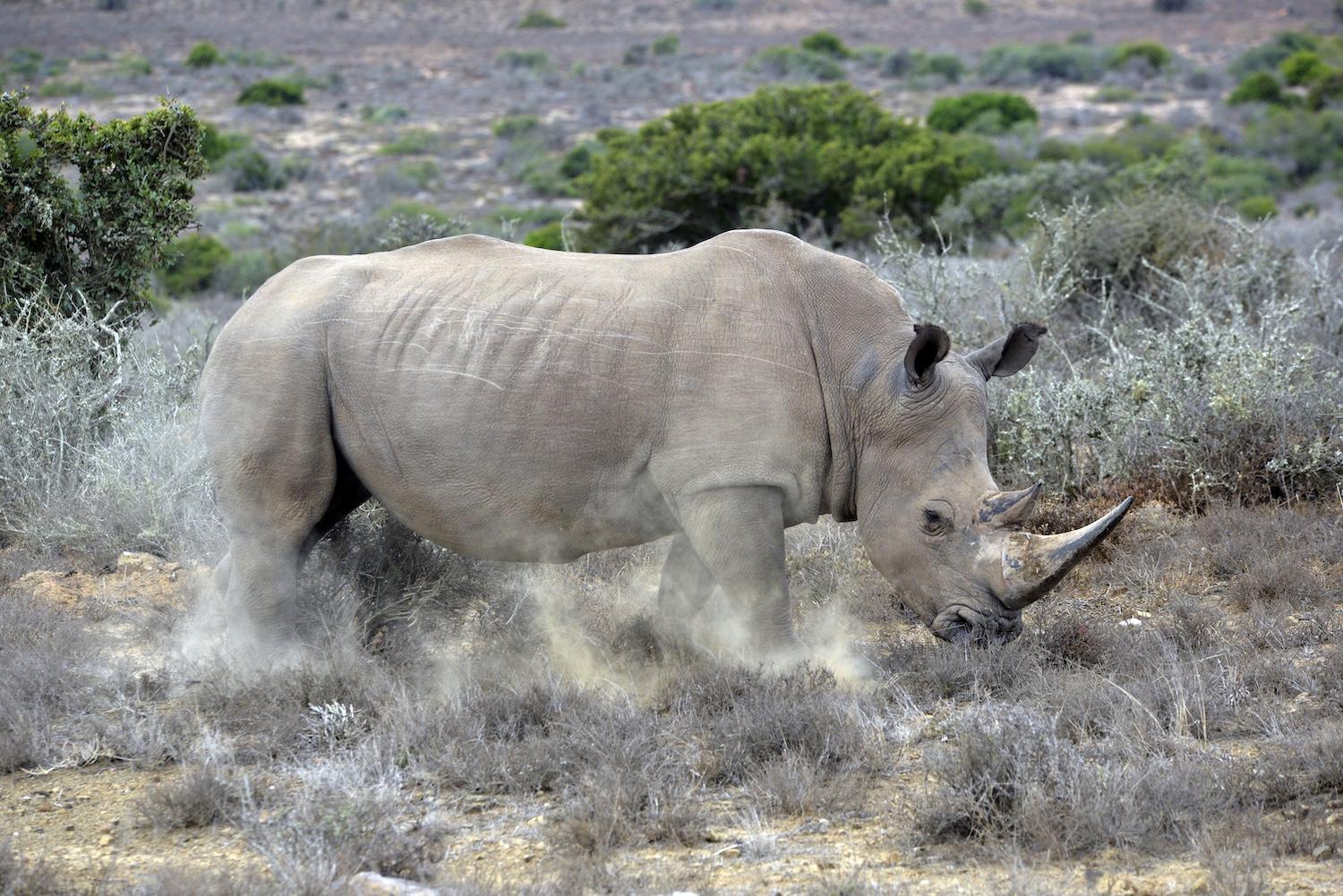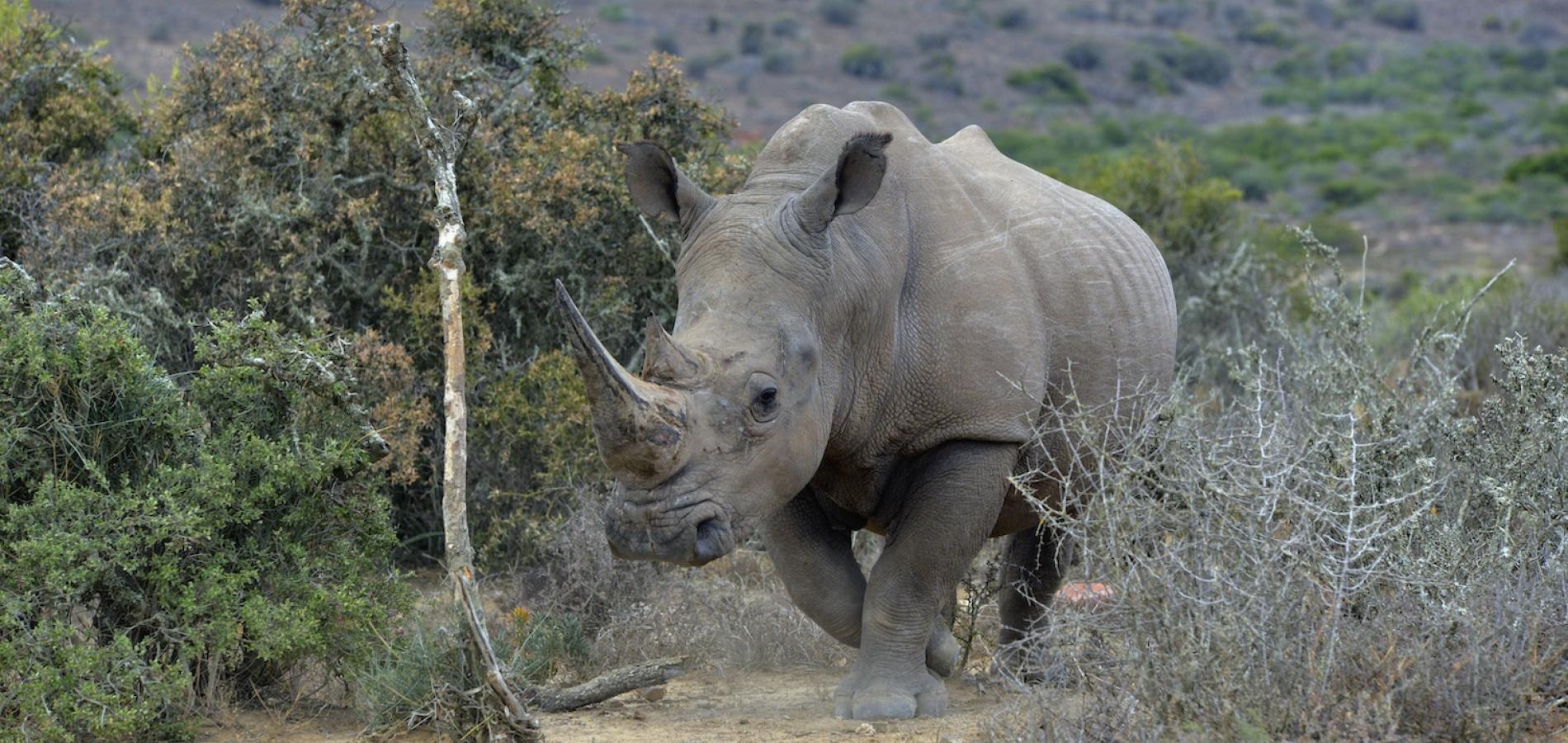The beleaguered park in the heart of South Africa’s Zululand
that was once the shining light in rhino conservation.
Editor's note: Across the globe, there are thousands of national parks and protected areas. To look at how other countries manage and protect their parks, and to introduce you to some incredible destinations, the National Parks Traveler occasionally will post a feature from abroad.
A pair of Southern white rhino graze beside a dirt-track in the northern sector of Hluhluwe-iMfolozi Park in South Africa’s KwaZulu-Natal province. The animals — judging by their relative sizes, a mother and pre-adolescent calf — seem unconcerned by the clicking cameras and whispered comments from the open-sided game-watching vehicle parked just a few meters away. The tourists meanwhile are clearly awed to be in such close vicinity to the mighty beasts that move, almost like slow-rolling boulders, above the swaying golden grass.
The mother’s 1,600-kilogram bulk rises just a little higher than that of her offspring, yet despite their intimidating size a sense of peace and tranquility seems to reign this dry-season morning in Hluhluwe-iMfolozi Park (pronounced ‘ghla-ghloo-we oom-foh-lo-zi’ but also referred to by the acronym HiP). The oxpecker birds that are known in Africa as the rhino’s security guards have little reason to raise the alarm. Only one aspect of the scene testifies to the ever-present threat that these majestic creatures are living under: the horns of both mother and calf have been sawn off by park staff in an effort to preserve the animals from the unwanted attentions of poachers.
The area around the Hluhluwe and iMfolozi rivers was once the royal hunting ground of King Shaka and a whole dynasty of Zulu kings. Throughout the latter half of the 1800s European hunters — both self-proclaimed ‘sportsmen’ and those driven by the insatiable market for skins, ivory and meat — had decimated wildlife throughout KwaZulu-Natal (KZN).
"By 1895 the situation was serious," conservation legend Dr. Ian Player wrote in his excellent book Zululand Wilderness, Shadow and Soul. "The discovery of a pocket of surviving white rhino, a species considered extinct, was the final stimulus for the proclamation of the reserves."

A dehorned white rhino in Hluhluwe-iMfolozi National Park. The operation (painless to the rhino) - costing almost US$500 per rhino and repeated every 15 months - places a heavy burden on parks that are already struggling with the massive costs of security patrols/©Mark Eveleigh.
Two years later this wilderness became Africa’s first official reserve, and most conservationists agree that were it not for this historic park there would probably not be wild rhinos left anywhere in Africa today. Throughout the next century, when rhino poaching was rife across the entire continent, Hluhluwe-iMfolozi’s rangers managed to protect a healthy breeding population of both Southern white rhino and the more elusive (and famously aggressive) black rhino.
The efforts were not without cost, however, and a monument at HiP’s Nyalezi gate commemorates more than 40 men and women who died in the war on poaching in KZN alone.
"The sun rises each day in glory of those who defended the parks of KwaZulu-Natal," said Dr. Player.
As warden of the reserve it was Player — and his Zulu friend and mentor Qumbu Magqubu Ntombela — who spearheaded Operation Rhino in the 1960s, through which the last 100-200 Southern white rhino were safe-guarded and given a secure haven in which to breed. Many hundreds of white and black rhino were transported from the reserve to reboot shrinking gene-pools across the continent. Thanks in great part to Player, Ntombela, and their Operation Rhino colleagues, numbers increased to around 20,000 wild rhinos throughout Africa within the next 50 years.
"I looked to them [the endangered rhinos] as a cause to which I was prepared to give my life," Player wrote much later (in 1991), "and for the next 12 years I was closely woven to their destiny."
By 2013 demand for rhino horn had exploded in Southeast Asia (especially in Vietnam) and it became clear that deaths from poaching surpassed rhino births. Today Hluhluwe-iMfolozi Park is still famous for its large rhino population and yet — more than 60 years after Operation Rhino showed conservation world that the near-impossible could be achieved — the future of these iconic creatures seems less assured than ever.

While black rhinos (whose thicket habitat and aggressive nature have to some extent protected them from poachers) the gentle White Rhino giants that graze on open savanna make relatively easy targets. Photo not taken in Hluhluwe-iMfolozi/©Mark Eveleigh.
The rhino’s of HiP are still protected by a heavily armed security force and, as is common practice in most African parks these days, the exact number of rhinos is never divulged. Losses are therefore also notoriously hard to estimate, but South Africa’s respected Daily Maverick newspaper reported in April 2024 that around 300 rhinos had been poached from within the park the previous year. In the face of such devastation, and with financial support from World Wildlife Fund, the park authorities announced the drastic decision to start dehorning their resident rhinos.
“KZN has played a critical role in rhino conservation in Africa,” WWF South Africa CEO Dr Morné du Plessis told Daily Maverick, “which is why we are committing resources towards supporting the authorities in their efforts to protect rhinos.”
Many experts view dehorning as a last resort since it involves the amputation of the creature’s own first line of defense and, in any case, only 20 percent of the valuable horn remains on the animal. Also, since the horns grow back (according to some estimates at the rate of up to 11 centimeters per year for the first two years!), the operation must be repeated regularly.
“The cost for dehorning one rhino is around 8000 rand (US$440),” Musa Mntambo, spokesman for Ezemvelo KZN Wildlife (the authority in charge of HiP), told the National Parks Traveler. “Funding is an on-going challenge since the animals need to be dehorned again after as little as 15 months. Ideally we need donors who can help us move with the times — supplying drones and funding smart fences with cameras to pick up would-be poachers before they enter the park. We also need additional field rangers so that we can increase foot-patrols, and there should be choppers to respond to incidents.”

White rhinos with horns like this have become an increasingly rare sight in the wild since dehorning has become a common policy in many parks and reserves/©Mark Eveleigh.
Technology and strategy aside, many believe that local communities will play an increasingly large part in determining whether Africa’s rhinos escape extinction. In a region where growing human populations infringe more tightly on wilderness areas, it’s crucial to ensure that local people benefit from reserves and the revenue that safari tourism brings. Without this there is little incentive for them to run the risk of reporting threats and falling foul of powerful poaching organizations.
The traditional inhabitants of Zululand, while being fearless hunters, have long had a tradition of respect toward the natural world, for the creator they call Nkulunkulu and for the spirits of the animals they hunted. With the future of the rhino once again hanging in the balance, anti-poaching rangers and many members of the public are fighting back increasingly desperately against the organized poaching syndicates.
Signs, written in blood-red, at Hluhluwe-iMfolozi’s entrance gates admonish citizens to report poaching. "They are stealing your childrens’ heritage," say the posters.
Mark Eveleigh has 30 years experience as a travel writer and is currently based between Indonesia and southern Africa. His latest book, 'Vagabond: A Hiker's Homage to Rural Spain', was listed among National Geographic's top six travel books for 2024.



 Support Essential Coverage of Essential Places
Support Essential Coverage of Essential Places






